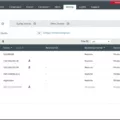Packet sniffing attacks on WiFi networks can be extremely dangerous and put your personal information at risk. In this blog post, we’ll discuss what packet sniffing is, how it works, and how to protect yourself from such an attack.
Packet sniffing is a type of cyber attack that involves intercepting data packets traveling across a network. It works by capturing network traffic with specialized software or hardware and then analyzing it for sensitive information. By doing so, an attacker can gain access to confidential data such as passwords, emails, credit card numbers, and more.
In order to launch a packet sniffing attack, the attacker needs to find an open WiFi network. Once they’ve found one, they can use specialized software or hardware to capture the data packets that are transmitted over the network. The attacker then analyzes the packets for any sensitive information that might be included in them.
The best way to protect yourself from packet sniffing attacks is to use secure Wi-Fi networks whenever possible. Make sure that you always connect to a secure wireless network with WPA2 encryption enabled whenever possible. Additionally, avoid using public Wi-Fi networks as they are often unsecured and vulnerable to packet sniffers.
You should also make sure that you install all security updates for your operating system and applications as soon as possible in order to keep your computer safe from potential vulnerabilities that could be exploited by attackers looking for open networks. Finally, consider using a Virtual Private Network (VPN) when connected to public wireless networks in order to add another layer of protection against packet sniffers.
By following these tips you can greatly reduce the chances of becoming a victim of a packet sniffing attack on any public or private wireless network you may connect to while out and about!

Packet Sniffing for WiFi: An Overview
Packet sniffing for WiFi is a technique used to intercept data packets that are transmitted over a wireless network. This process involves capturing, decoding, and analyzing the radio waves that contain information such as usernames, passwords, email addresses, credit card numbers, and other confidential data. Packet sniffing tools are commonly used by network administrators to keep an eye on the networks they manage and troubleshoot any potential issues they may encounter. On the other hand, malicious actors may use packet sniffing tools to scan for vulnerable networks or to steal sensitive information. When setting up a wireless network, it is important to take steps to protect it from packet sniffers by enabling encryption protocols such as WPA2 or WPA3.
The Possibility of Sniffing WiFi
Yes, it is possible to sniff WiFi. WiFi sniffing, also known as packet sniffing, is a method of monitoring the traffic on a wireless network. It allows you to capture data packets that are being sent across the network and analyze them for information such as passwords, web browsing activity, email content, and more. It can be used for legitimate purposes such as network performance monitoring or troubleshooting, but can also be used for malicious activities like stealing sensitive data or spying on users.
Understanding Packet Sniffing Attacks in Network Security
Packet sniffing is a type of network security attack that involves capturing data packets as they travel across a network. Attackers use packet sniffers to intercept and read sensitive data such as unencrypted email messages, login credentials, and financial information. Packet sniffing attacks can be conducted in a variety of ways, including through wireless networks, Ethernet cables, or by installing malicious software on an unsuspecting user’s computer. As such, it is important for organizations to ensure their networks are secure against these types of attacks by using strong encryption protocols and authentication measures. Additionally, organizations should regularly monitor their networks for suspicious activity.
Can Packet Sniffing Be Detected?
Yes, packet sniffing can be detected. Packet sniffing is a type of network monitoring that involves intercepting and analyzing network traffic to detect any malicious or suspicious activity. In a shared Ethernet environment, packet sniffing is typically done using a promiscuous mode, meaning that the network card is configured to accept all packets on the shared segment regardless of their destination address. This means that the packet sniffer can capture all packets sent over the shared segment, including those not intended for it.
However, while it is difficult to detect a promiscuous mode packet sniffer in a shared Ethernet environment, there are several measures that can be taken to detect and/or prevent it. For example, using port mirroring or port spanning techniques to monitor traffic on specific ports or VLANs can help detect suspicious activity associated with packet sniffers. Additionally, deploying Network Intrusion Detection Systems (NIDS) and Intrusion Prevention Systems (IPS) can help identify malicious behavior such as unauthorized access attempts or data manipulation attempts. Finally, implementing proper security protocols such as enabling encryption for sensitive traffic and disabling unused ports can also limit the effectiveness of packet sniffers in shared Ethernet environments.
Does a VPN Prevent Packet Sniffing?
Yes, a Virtual Private Network (VPN) can help prevent packet sniffing. When you use a VPN to browse the internet, your data is routed through an encrypted tunnel. This encryption prevents hackers from being able to ‘sniff’ your data packets as they travel over the network. Furthermore, the IP address assigned to your device by the VPN is not the same as your public IP address, making it even more difficult for someone to identify and track your online activities. Therefore, using a VPN will significantly reduce the risk of packet sniffing.
The Impact of Packet Sniffing Attacks on Free Wi-Fi Networks
Yes, packet sniffing attacks can use free Wi-Fi networks to capture data. Packet sniffing is a type of cyber attack in which a malicious actor uses specialized software to intercept and collect data from an unsecured wireless network, such as one that is offered at a coffeehouse, airport, mall, or hotel. The attacker is able to collect information like user names, passwords, credit card numbers, and emails without the user’s knowledge. It is important that users take steps to protect themselves when using public Wi-Fi networks by using encryption tools and avoiding sites that require sensitive information.
Is Packet Sniffer a Form of Spyware?
No, a packet sniffer is not considered spyware. It is a software or hardware tool that captures and logs packets of data as they pass through an internet network. Packet sniffers are often used for legitimate purposes such as monitoring network performance, troubleshooting network issues, and detecting intrusions. That said, packet sniffers can be used for malicious purposes if the person using them has access to the network. Therefore, it is important to ensure that the user of the packet sniffer has the authorization to use it on that network.
Preventing Packet Sniffing Attacks
Packet sniffing attacks are a form of cyber attack that involves eavesdropping on network traffic with the goal of intercepting sensitive data. To prevent packet sniffing attacks, it is important to use a combination of security measures, including strong encryption protocols, firewalls, and anti-virus software.
Encryption protocols such as Secure Socket Layer (SSL), Transport Layer Security (TLS), and IPsec can be used to protect data in transit by scrambling the contents so that only the intended recipient can decrypt it. Firewalls can be used to block ports and IP addresses from which an attacker could launch a packet sniffing attack. Anti-virus software should also be used to detect malicious packets and prevent them from entering your network. Lastly, it is important to monitor user activity for any suspicious network access attempts.
Conclusion
In conclusion, packet sniffing is a technique used by both hackers and network administrators to monitor and analyze the data flowing across a network. For malicious purposes, packet sniffers can be used to intercept sensitive data such as unencrypted email messages, login credentials, and financial information. However, it can also be used for legitimate network monitoring purposes by administrators. Therefore, it is important for users to take proper precautions when connecting to public networks such as using encrypted connection methods and only accessing secure websites. Additionally, administrators should use best practices for network monitoring such as implementing an Intrusion Detection System (IDS) or other security measures.








